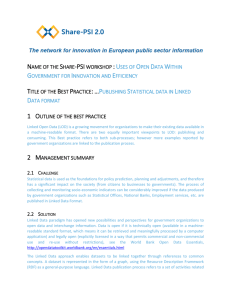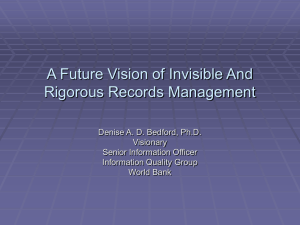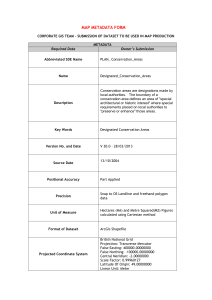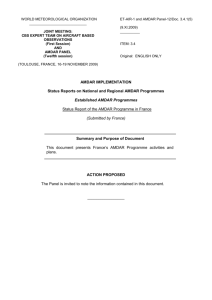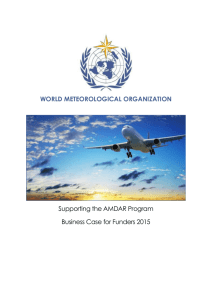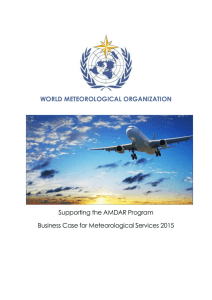amdar
advertisement
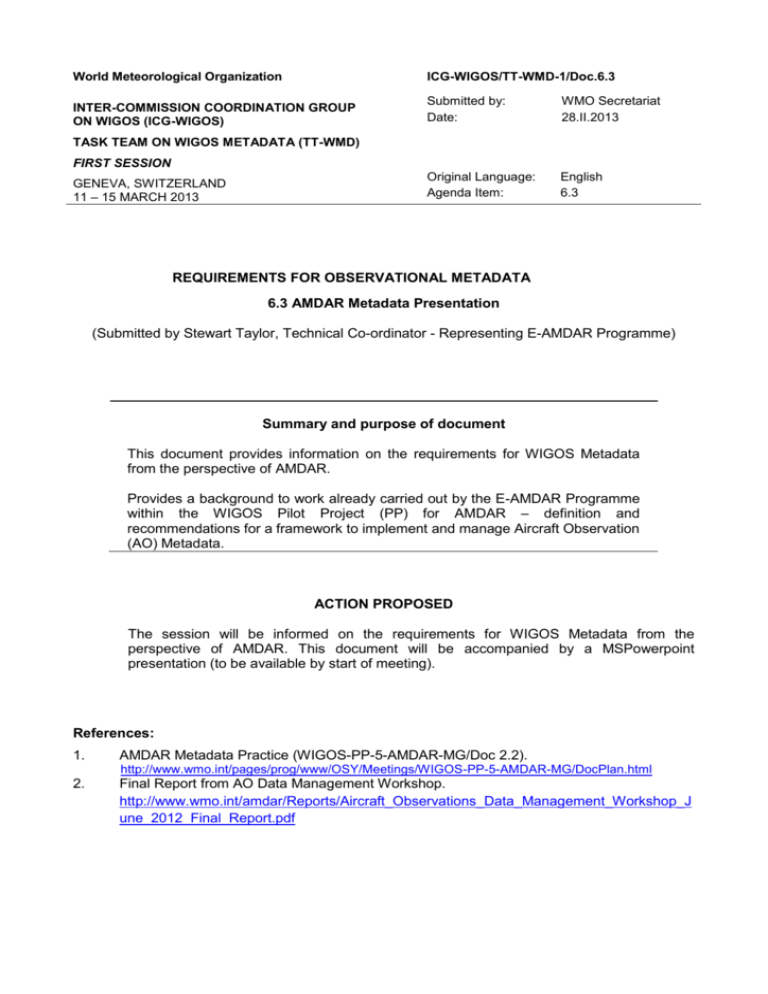
World Meteorological Organization ICG-WIGOS/TT-WMD-1/Doc.6.3 INTER-COMMISSION COORDINATION GROUP ON WIGOS (ICG-WIGOS) Submitted by: Date: WMO Secretariat 28.II.2013 Original Language: Agenda Item: English 6.3 TASK TEAM ON WIGOS METADATA (TT-WMD) FIRST SESSION GENEVA, SWITZERLAND 11 – 15 MARCH 2013 REQUIREMENTS FOR OBSERVATIONAL METADATA 6.3 AMDAR Metadata Presentation (Submitted by Stewart Taylor, Technical Co-ordinator - Representing E-AMDAR Programme) Summary and purpose of document This document provides information on the requirements for WIGOS Metadata from the perspective of AMDAR. Provides a background to work already carried out by the E-AMDAR Programme within the WIGOS Pilot Project (PP) for AMDAR – definition and recommendations for a framework to implement and manage Aircraft Observation (AO) Metadata. ACTION PROPOSED The session will be informed on the requirements for WIGOS Metadata from the perspective of AMDAR. This document will be accompanied by a MSPowerpoint presentation (to be available by start of meeting). References: 1. AMDAR Metadata Practice (WIGOS-PP-5-AMDAR-MG/Doc 2.2). http://www.wmo.int/pages/prog/www/OSY/Meetings/WIGOS-PP-5-AMDAR-MG/DocPlan.html 2. Final Report from AO Data Management Workshop. http://www.wmo.int/amdar/Reports/Aircraft_Observations_Data_Management_Workshop_J une_2012_Final_Report.pdf ICG-WIGOS/TT-WMD-1/Doc. 6.3, p. 2 ____________ 6.3 AMDAR PRESENTATION 1. BACKGROUND a. The requirements and application of AO Metadata management is a task included in the WIGOS Pilot project for AMDAR (WIGOS-PP-AMDAR). i. WIGOS PP has agreed on components of metadata and in particular, identified Metadata required to describe data and products, Metadata required for the usage of the data and Metadata required for the operation of the AMDAR observing system. ii. A task for the E-AMDAR Programme was to approach participating airlines with the draft dataset – this would be populated with information obtained from an airline and presented to WIGOS-PP-AMDAR. 2. STATUS OF METADATA IMPLEMENTATION a. The E-AMDAR Technical Co-ordinator (as Metadata Manager for E-AMDAR Programme) has part-populated the metadata dataset agreed in Appendix III of the Final Report to AO DM Meeting (reference 2). b. The metadata dataset is included in Appendix I to this document. It should be noted that some elements of the metadata dataset are not available at this time. More information on this is reported on below. c. In discussions with the airlines, it may be necessary to add another element regarding the aircraft information. As well as Type and Series, the aircraft will also have a Model Type. For example: Aircraft Type = A320 (Family), Aircraft Series = A319-100 and Aircraft Model = A319-112. 3. DEFINITION OF FRAMEWORK a. In order for the metadata to be obtained, several stakeholders will be required to contribute. i. Metadata Manager (MM). ii. Airlines. iii. Data Service Providers (DSP). iv. Avionics vendors. v. Aircraft manufacturers. vi. Aviation authorities. vii. NWP Monitoring Centres. b. The responsibilities of the above identified stakeholders will be as follows; i. A member of the Regional AMDAR Management Team (in Europe this will be EAMDAR Technical Co-ordinator) will be responsible for contact with the other stakeholders for data input to the metadata dataset. ii. Point of contact for AMDAR/Datalink matters for provision of metadata information relating to aircraft identification and software equipage. iii. Point of contact for AMDAR/Datalink matters for provision of metadata information relating to data communications iv. Point of contact for information on airframe hardware and software implementation. v. Point of contact for information on airframe sensor equipage (future metadata dataset requirements). vi. Point of contact for information relating to Airport metadata. vii. Point of contact for information relating to data quality of aircraft observations. c. There will also be a requirement for clearly defined processes and procedures for the population and maintenance of the metadata. ICG-WIGOS/TT-WMD-1/Doc. 6.3, p. 3 i. Identification of the MM for the Regional AMDAR Programme and assign responsibilities. ii. Metadata template to be populated by MM. iii. Agree schedule of metadata maintenance (upkeep) – to ensure current and up to date information available (a weekly, monthly update or on ad hoc basis?). iv. Updates to metadata made known to all users of the dataset. v. Visibility of the metadata to all users. There is a requirement to consider IT infrastructure of developing countries – are they able to access metadata format. vi. Implement procedures for reporting faults/errors on aircraft. d. The defined processes and procedures will need to conform to a set of agreed standards. i. Standard metadata template used by all AMDAR Regional Programmes. ii. Metadata entries all conform to set reporting units (e.g. seconds for reporting intervals). iii. Ensure maintenance schedule adhered to. iv. Ensure access to metadata by all users. v. Defined Fault reporting format. 4. TECHNICAL REQUIREMENTS a. The requirements for the implementation of a metadata dataset to be defined. b. Consideration of the IT infrastructure available at NMHSs where the MM would populate and maintain the dataset. i. Agree data format e.g. excel spreadsheet, csv file, xml etc. c. Along with point b above, consideration would also need to be given to the IT infrastructure of metadata users – especially those users in developing countries. i. Agreed data format would need to be accessible by all users. 5. IMPLEMENTATION a. There should be an initial test of the metadata dataset carried out between Regional AMDAR Programmes. i. With the E-AMDAR Programme providing the first draft of metadata from European airlines, this would be a starting point. ii. There will be some development required to incorporate the first draft of the EAMDAR metadata dataset into WMO. iii. This should be discussed and agreement on how this is to be achieved – resources and timescales. b. The testing and required development at WMO would be in line with WIGOS-PPAMDAR timescales. 6. RISKS a. The need for appropriate level of resources for a MM to carry out the responsibilities listed above need to be factored into Programmes costs. i. Monitoring of MM resources should be carried out to ensure no overloading of workload is introduced – this could lead to the metadata dataset not being maintained correctly. b. The willingness of stakeholders to impart information required for the mandatory elements of the metadata dataset needs to be considered. i. During the course of populating the E-AMDAR metadata dataset, the MM encountered various levels of co-operation. ii. Several airlines provided Aircraft Tail Numbers/Registration Details (that could be linked to EU Identifier) to enable metadata fields to be completed. However, some of the major players – DLH, SAS and AFR (amounting to over 70% of the E-AMDAR fleets) would not impart this information citing Pilot Union Contracts and Airline Policies. iii. The Tail Number/Aircraft Registration and Manufacturer Serial Number (MSN) are all connected and to be of any significance within the metadata need to have the correlation with the EU Identifier. ICG-WIGOS/TT-WMD-1/Doc. 6.3, p. 4 iv. This is a major setback for QC of aircraft. The need for the Airline Tail Number being matched to an EU Identifier ensures that the EU Identifier only relates to one aircraft at the airline. v. A summary of the negative responses from DLH and SAS is included in Appendix 2. vi. If we wish the airlines to provide this data, we will need to make representations to the Airline Pilots Unions and Senior Management. There is no guarantee that this information will be supplied. 7. CONCLUSION a. The E-AMDAR metadata dataset mandatory fields could be fully populated for some of the participating airlines. b. The remaining airlines would be able to provide “restricted” metadata – see example in Appendix 1. c. This might be the case for other Regional AMDAR Programmes. i. This will need to be surveyed immediately. ii. The findings of this survey may see the need to review the Mandatory fields proposed in the AO Metadata dataset. _____________ ICG-WIGOS/TT-WMD-1/Doc. 6.3, p. 5 Appendix 1. E-AMDAR Example of Metadata – as provided by selected airlines (SAS, BLF and FIN). Below is a subset of the metadata spreadsheet that has been complied by E-AMDAR MM. As indicated by the RED column header, this information is currently not supplied by all airlines. The BLUE column header (Aircraft Tail No.) relates to historical information from the E-AMDAR fleets – early AFR, BAW and the SAS B767 fleet (now out of service). This information is now “patchy” and could be replaced by Aircraft Registration. There will need to be some amendments to the Columns Aircraft Type/Series (GREEN column header) and the addition of Aircraft Model. The complete MSExcel spreadsheet is held by the E-AMDAR MM. AMDAR Identifier Aircraft Tail No. Aircraft Registration Airline Airline Contact Activated for AMDAR Aircraft Manufacturer Aircraft Type Aircraft Series Aircraft MSN Airline Avionics Vendor Airline Onboard Hardware AMDAR Software AMDAR Software Version AMDAR Software configurable EU0250 SAS 17/05/2006 Airbus 321 232 Honeywell ACARS AOC on ATSU A620 2 Y EU0824 SAS 17/05/2006 Airbus 321 232 Honeywell ACARS AOC on ATSU A620 2 Y EU1521 SAS 17/05/2006 Airbus 321 232 Honeywell ACARS AOC on ATSU A620 2 Y EU0217 LN-TUA SAS 2010 Boeing 737 705 28211 Teledyne DMU (ACMS) A620 4 Y EU0218 LN-TUD SAS 2010 Boeing 737 705 28217 Teledyne DMU (ACMS) A620 4 Y EU4110 EU4215 EU0240 OH-LVA OH-LVB OH-BLJ FIN FIN BLF 01/10/2010 Airbus Airbus Boeing 319 319 717 112 112 21S 1073 1107 55065 Honeywell ACARS AOC on CMU Mk2 A620 2 Y EU0241 OH-BLM BLF 01/10/2010 Boeing 717 23S 55066 Honeywell ACARS AOC on CMU Mk2 A620 2 Y ICG-WIGOS/TT-WMD-1/Doc. 6.3, p. 6 Appendix 2. Discussions with SAS. Latest discussions with SAS reveal that any divulging of Aircraft Registration (Tail Number) – assigned to EU Identifier, would be in breach of Agreement with the Pilots Unions. “…Regarding the EU Number vs Tail number list: Personally I would have no problems sending you this information. However, as you probably know, we suffer from heavy restrictions on our data presentation by our agreement with the pilot unions. Due to this agreement all flight data we send out of SAS must be anonymous. We (CPHOS) have enforced this agreement by not telling you which specific aircraft is assigned which EU number, but only that a given EU number applied to a given aircraft type. I find the data you receive in the MET observations quite harmless, but others may disagree. Anyway I will need to get approval before forwarding the information you request. I am seeking this approval right now, but I cannot give you any guarantees. If I receive the approval I will fulfil your request instantly”. However, certain elements of the metadata dataset will be made available e.g. ACARS information. “…If it would be sufficient for you, that we for each EU ID supplied the AC type info and onboard data acquisition type (e.g. Honeywell FDAMS/Teledyne FDIMU/etc.) ACARS info, but without tail number/AC registration, we could provide that soon. I guess we can start doing this, no matter what”. (This was agreed with our SAS colleagues – the ACARS info will be added soonest). “…If you must have the tail number, a new process of getting approval from the pilot unions of the three Scandinavian countries will have to take place, and it may be time consuming and the result unpredictable”. Discussions with DLH. Below is the latest response from Lufthansa. There has been no change in policy since the start of the E-AMDAR Programme. In discussion with the airline AMDAR contact, it would appear that there is probably no scope for movement form the Pilots Unions. “…When starting DLH AMDAR in 1998 we had to ask for an agreement with our pilots. The pilots insisted that no tail signs should be used or that the tail sign should be encoded (as we do with the EU numbers). In other words I cannot provide the transfer list officially”. _______




